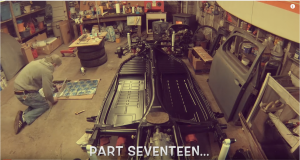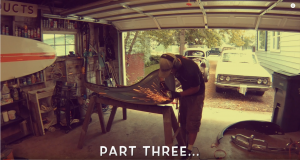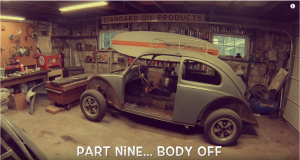Tools Needed:
Not many tools are needed for this step, but they’re important tools that we’ll use a lot throughout the restoration:
- Air compressor – an air compressor is also a must for almost all steps in a restoration. Not just painting, but DA sanders, air chisels, sand blasting, etc – I don’t have a fancy one, but I’d invest in the best you can afford. Mine is a simple 20 gallon, but would love to be able to afford a better one.
- HVLP spray gun – for primer, I buy the cheap anodized purple HVLP guns from Harbor Freight – they work great and are very affordable. I have a couple with different tip sizes that I’ve drilled out to handle thicker paint when needed. You won’t want to use these for your final paint job, but for this step I’d suggest buying one.. or two. Along with the spray gun, you probably want a moisture trap and pressure regulator unless you’re brave or just want to take your chances.
- Respirator – get a good respirator with the correct filters for auto paint. I asked my friend who owns a local body shop, but you can ask your local guy since I don’t know much about the filters – just make sure you have the right one so you’re not breathing those fumes.
- DA Sander – I used a DA sander to sand down the fenders after being sandblasted, but this can be done with sandpaper and sanding blocks – it’ll just take longer
- Sanding blocks – another thing you’ll use in this step and many, many steps later when we get to the body work is a few different size and hardness of sanding blocks
- Sandpaper – I buy rolls of sandpaper from the local paint supply store. For this step I’m using 180 grit
Materials/Products Needed:
- Epoxy primer – the primer I used for this project was Lucid Technologies EP 210 which can also be used as a primer sealer
- Wax and grease remover – the final step before painting, I used a wax/grease remover to do the final wipe down. I used Omni MX-190 which I also used for my 67 restoration and worked great.
Cleaning and priming fenders:
The fenders are sandblasted, final welds have been made, and fiberglass filler has been applied. I’m ready to cover the fenders with some primer to prevent and rust between now and the time I get to the body work and paint.
Sanding the fenders:
After getting parts sandblasted, I want to make sure the parts are clean of any sandblast material and residue. I used a DA sander with 180 grit paper to go over the fenders completely for a consistent surface before priming. I used the DA sander on the areas I could reach, then used a sanding block with 180 grit paper to get all the areas I couldn’t reach. And any small areas that I couldn’t reach even with the small sanding block, I used sandpaper by hand. Basically I just wanted a consistent surface all around – top and bottom of the fenders.
Cleaning the fenders:
After sanding, I wiped the fenders down with the wax and grease remover. This took several passes before the cloth was coming out clean. I wiped the fenders down, flipped the cloth, wiped more, then moved to a new cloth and repeated until there was no more to clean. Wearing rubber gloves for the last pass to be sure no more grease from my hands was being transferred to the fenders.
Finally ready for primer:
Ok, finally. Fenders are smooth and clean and ready for primer. I hung the fenders with wire and string from the garage rafters so I could hit them all at once. I mixed the primer with the suggested mixture (make sure to get a spec sheet for the primer you’re using) and adjusted the gun pressure and spray pattern and went to work.
This was the first time I had used this HVLP gun – so before painting I had to clean it so there was no assembly lube or anything left that would contaminate the primer. So that’s just a fun extra step with a new gun.
Now that the fenders are primed, I can rest easy that they’ll be safe while I put them away until I’m ready to start on the real body work. The fender that you see closest to the camera on the left was in rough shape and will have a lot of work left to do, but I’d rather attempt to save an original part rather than buy a cheap aftermarket fender. So we’ll see how it turns out as this restoration continues!



